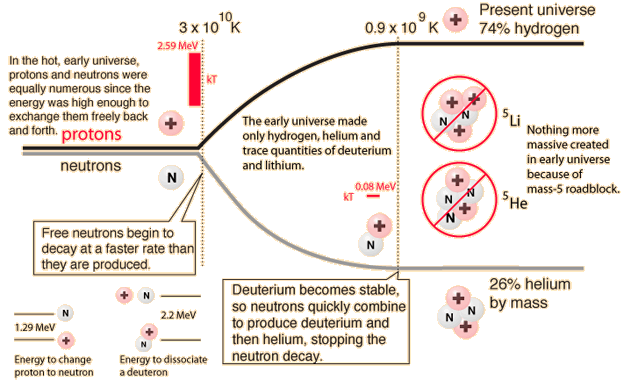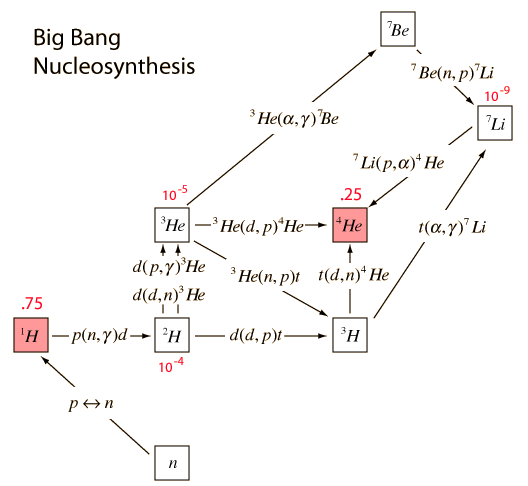Hydrogen-Helium Abundance
Hydrogen and helium account for nearly all the nuclear matter in today's universe. This is consistent with the standard or "big bang" model. The process of forming the hydrogen and helium and other trace constituents is often called "big bang nucleosynthesis". Schramm's figures for relative abundances indicate that helium is about 25% by mass and hydrogen about 73% with all other elements constituting less than 2%. Carroll & Ostlie give 23 to 24% helium. There is a window of uncertainty, but it is clear that hydrogen and helium make up 98% plus of the ordinary matter in the universe. This high percentage of helium argues strongly for the big bang model, since other models gave very small percentages of helium. Since there is no known process which significantly changes this H/He ratio, it is taken to be the ratio which existed at the time when the deuteron became stable in the expansion of the universe. This ratio is significant as a test of cosmological models since it will be affected by the time period from the time when the temperature dropped below that necessary to produce neutrons from protons to the time when the deuteron became stable, halting the decay of the free neutrons.

Basically , the hydrogen-helium abundance helps us to model the expansion rate of the early universe. If it had been faster, there would be more neutrons and more helium. If it had been slower, more of the free neutrons would have decayed before the deuterium stability point and there would be less helium.


|
The modeling of the production of helium and the hydrogen-helium ratio also makes predictions about other nuclear species, particularly 7Li, 2H(deuterium) and 3He. These observed abundances simultaneously fit the big bang model within a narrow range. The shaded areas represent measurements from regions which have a very small abundance of heavy elements, so that they seem to be good samples of primordial abundances. Besides being a sensitive test of the big bang model, the abundance of helium also correlates best with three types of neutrinos, rather than two or four. The presence of another neutrino species, and thus another round of leptons would give a higher helium abundance by about a percent.
The ratio of the number of baryons per photon was one of the contributions of the discovery of the 3K background radiation. Those measurements permitted a calculation of the photon energy density in the universe and the range of estimates for baryon density gave a baryon/photon ration of about 10-9.
Data from Boesgaard, A. M. and Steigman, G., "Big Bang nucleasynthesis: Theories and Observations", Ann. Rev. Astron. and Astrophys. 23, 319 (1985).
|
|
Index
References
Trefil
Schramm
Big Bang ...
Harwit
Ch 12
Carroll & Ostlie
Ch 29 |



